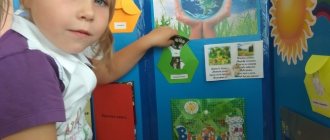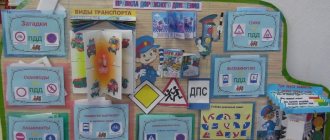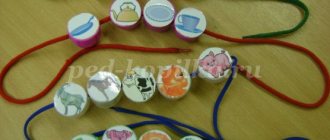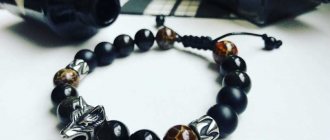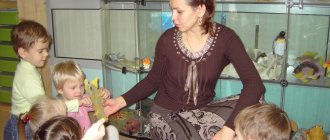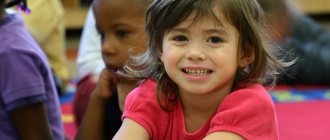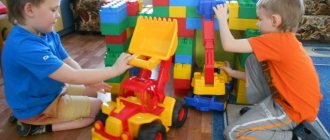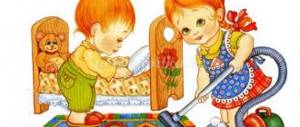Lapbook Musical Kingdom – Lapbooks – Educational games and manuals – File catalog
LAPTOP MUSICAL KINGDOM
Author: Tatyana Belan
Interactive folder, manual for preschool and primary school children. A laptop can be considered a form of organizing educational material that a preschool child masters and consolidates. A laptop is a universal tool whose purpose is quite broad. It can be used in group, subgroup and individual work with children on music education.
The purpose of using a lapbook in music education is to ensure the child’s activity and variety of practical activities in the process of realizing the artistic and aesthetic development of a preschooler.
A laptop is a universal tool whose purpose is quite broad. It contains sections that are necessary for teaching children to play music and master the basics of musical literacy:
Lapbook contents:
1. Mini-book “Musical Kingdom”
(introduction to the treble clef, game tasks and travel plan to the musical kingdom)
2. “Name the notes”
(bright colored picture cards for remembering the names of notes)
3. “Musical Domino”
(to fix the location of notes on the staff)
4. Riddles about music
5.Secret envelope
(Rebuses “Instruments of a Noise Orchestra”)
6. Creative tasks “Major and minor”
7. Game “Guess what I’m playing” (colored cards depicting musical instruments and performers)
8. Secret envelope “Put it together” (puzzles “Musical instruments”)
The pockets and envelopes of the lapbook are filled with content in accordance with the tasks to be solved in the lesson and the individual characteristics of preschoolers.
You can watch a master class on making a lapbook here
Lapbook layout diagram in expanded form
The cost of the electronic version of the “Musical Kingdom” lapbook is 250 rubles
Instant purchase service , a payment form that allows you to make payments through an electronic wallet in the WebMoney system, by bank card, through terminals, by topping up from a mobile phone account, etc. The material is sent out automatically.
1.Click on the “Order Now” button
2.Enter your email address correctly
3.Click “Place an order”
4. Select a payment method
Order now
After confirmation of payment, you will receive an information letter to the specified email address “You have paid invoice No...”, it will contain a link to download the order you paid.
When filling out this form, please make sure your mailing address is correct!
For any questions, please refer to the “ Feedback ”
Copying, transfer to third parties, posting on the Internet, as well as commercial use of materials is strictly PROHIBITED! All rights reserved!
muz-rukdou.ru
Lapbook Music
October 29, 2020 dorohinaov
The “Music” laptop is aimed at activating curiosity and cognitive activity in the field of music education; allows you to expand children's understanding of musical instruments, their types, the orchestra, and notes; trains in describing music, its sensory understanding; promotes the development of memory, thinking, attention, perception, speech.
General form:
lapbook music
lapbook music
The laptop includes a number of games and exercises:
- Lotto “Musical Shadows” for the development of perception, classification of instruments;
Lapbook music, games
- Game “Song, Dance and March” to get acquainted with various genres of music;
Lapbook music, games, song, dance and march
- the game “Odd Four” to eliminate an instrument based on its belonging to a certain type;
music, fourth wheel
- cards with Riddles about musical instruments and musical concepts;
music, riddles
- the game “Rhythmic Drawings” for finding and playing various rhythms;
Lapbook, music, rhythm
- Folding cards “Orchestra”, “Stave”;
Lapbook, music, stave
Lapbook, music, orchestra
- game “Memorize and repeat” with fields for laying out from memory;
Lapbook, music, memory
- the game “Cut Pictures” for the development of perception and recreating imagination;
Lapbook, music, cut-out pictures
- pictures with the names of parts of different types of musical instruments (trumpet, violin, accordion and harp) for comparison and expansion of vocabulary;
Lapbook, music, musical instruments
- the game “Continue the Row” to reinforce the sequence of notes using the example of a piano;
Lapbook, music, stave
- the game “Name the Instrument” to get acquainted with the variety of musical instruments and learn to classify them by type;
Lapbook, music, musical instruments
- the game “Describe the Music” for the emotional and qualitative characteristics of music of its various genres; musical coloring pages and activities.
Lapbook, music, description of music
You can purchase a laptop in a store or by paying through the Robokassa system:
Robokassa
{lang: 'ru'}
Didactic manual Lapbook “Musical Klondike”
"MUSICAL KLONDIKE"
Lapbook in the musical development of children of senior preschool age
Kobeleva Olga Sergeevna,
musical director of MBDOU
D/s "Firefly", I qualification category.
One of the main tasks of the Federal State Educational Standard for Preschool Education is to preserve and support the child’s individuality, develop his abilities and creative potential. This is achieved by using an individual approach to children, which should permeate the entire educational and educational environment of a preschool educational institution. In communication, in organized educational activities, in games, we should not forget for a minute that a child is a unique personality.
One of the targets at the stage of completing preschool education is the manifestation of initiative and independence in various types of activities, including music. Independent creative activity of a child is possible provided that a special subject-development environment is created. Based on this, a didactic manual lapbook “Musical Klondike” was created based on musical and didactic games, which are one of the most accessible means of learning music that meet the capabilities, characteristics, interests and needs of the child. The value of musical and didactic games is that they open up a way for the child to apply the acquired knowledge in life practice.
It should be noted the multifunctional nature of the “Musical Klondike” lapbook, which can be considered as one of the game forms of learning, as an independent musical and gaming activity, as a means of musical communication between a child and an adult.
Target:
ensuring the child’s activity and variety of practical activities in the process of realizing the artistic and aesthetic development of a preschooler.
Tasks:
- Promote a better understanding and memorization of the material being studied and the application of the experience gained in new life situations.
- Support children's cognitive activity, initiative and independence in musical activities.
- Create conditions for joint musical activity between children and adults.
- Activate children's vocabulary.
Content mastered by children
The laptop corresponds to the main educational program of preschool education of MBDOU D/s “Firefly” (educational field of artistic and aesthetic development: musical and artistic activities).
Components of a lapbook.
The musical and didactic manual lapbook “Musical Klondike” was created for children of senior preschool age. It is a cardboard folder of A 4 format, consisting of four pages.
On the pages of the folder there are various pockets and cards containing didactic games and tasks aimed at developing the musical abilities of children.
- Musical and didactic game “Three Whales”.
- Musical and didactic game "Teremok".
- “Rhythmic riddles”: cards with a rhythmic pattern, magnetic tape with large and small magnets, metallophone, wooden sticks.
- Disc with music to listen to.
- Cards depicting emotions and illustrations for musical works, portraits of composers.
- Musical and didactic game “Find a Pair”.
- Musical and didactic game “Fold, find out and sing” (cut-out pictures for children's songs).
- Musical and didactic game “Musical Journey” (game board, cube, chips).
- Riddles about music.
Description of the possibilities of using a laptop
"Musical Klondike".
Musical and didactic game “Three Whales”
This didactic material is a house, in the upper windows of which there are three pillars of music and an envelope with a set of cards depicting various musical genres: dance, song, march.
Target:
enrich children's musical experience and develop the ability to determine the genre of a piece of music while listening to music.
Option 1.
The child independently places cards corresponding to genres of music into empty windows, and names the genre.
Option 2.
An adult invites the child to listen to an excerpt of a piece of music. The child chooses a card that matches the genre of this piece of music and places it in the empty window.
Musical repertoire
(presented on disk)
“Song of Friends” by V. Gerchik
“Naughty Polka” by N. Verosokina or “Under the Green Apple Tree” (r.n.p., arr. by R.Rustamova).
“March” by T. Lomova or “March” by N. Bogoslovsky.
Note.
The game can be used both in organized educational activities with preschoolers and children independently outside of music classes in play activities.
Musical and didactic game "Teremok"
Target.
Developing the ability to recognize musical works, convey the musical image of a fairy-tale hero through song and expressive movements.
Game material.
A picture depicting a tower, cards depicting fairy tale characters: fox, bear, wolf, frog, bunny, mouse, cockerel.
Option 1.
(One child or several children can play.)
The child chooses a character and independently tells a fairy tale, singing the characters’ songs, imitating their intonation.
Option 2.
The adult invites the child to listen to the melody and guess who will run up to the tower and ask to enter it. The child chooses a picture depicting the corresponding character, answers and motivates his answer with a characteristic about this musical passage, and places the picture in front of the house. And so, about all the heroes of the fairy tale.
Option 3.
(Several children play, an adult as a leader.)
An adult invites the children to listen to a piece of music. Each child has a card with a picture of a fairy tale character; after listening to each character's play, the children raise the corresponding card, explaining their choice. Then the children are asked to depict the movements of the hero of the fairy tale.
Musical repertoire
(presented on disk).
Plays: “Bear”, “Fox”, “Mouse”, “Bunny”, “Wolf”, “Frog”, “Cockerel” by G. Levkodimov
Page "Rhythmic riddles"
Target:
development of a sense of rhythm in children.
On the central page of the lapbook there is a metallophone and wooden sticks to give the child the opportunity to choose, cards depicting rhythmic patterns, magnetic tape and magnets of different sizes to indicate the duration of the sound (large - long sound, small - short sound).
From a large envelope, the child selects a card with a rhythmic pattern and independently plays the rhythm on a metallophone, wooden sticks, or claps it with his hands. This task can be completed by one child or several children, dividing the cards among themselves. The drawings on the rhythm cards are selected taking into account the gender characteristics of children.
In a small envelope there are tasks aimed at developing in children the ability to correlate sounds in pitch and distinguish the direction of movement of a melody.
Using magnets, the child independently lays out a rhythmic pattern and performs it on a metallophone, wooden sticks, or claps it with his hands.
"Listening to music"
(interaction with an adult)
At the top of the third page there is a disk with musical works, pictures corresponding to these works, portraits of composers, pictures with different expressions of mood: sadness, anger, fun, surprise, fear, grief, reflecting the nature of the music.
Target:
development of memory and musical ear.
An adult invites the child to listen to a piece of music. The child names the piece, finds the corresponding picture and the composer who wrote this music.
You can play a game to determine the mood of the music.
Target:
developing children’s ability to determine the mood of a piece of music and express the mood with facial expressions.
Option 1.
The child listens to works of a different nature and characterizes each passage of the works he listens to, choosing the appropriate card with an emotion.
Option 2.
Children are encouraged to use facial expressions and movement to express the mood of the piece they listened to and to show their creativity.
Musical and didactic game “Find a Pair”
The files contain cards with portraits of composers, illustrations for their works, and musical instruments. Using a marker, the child connects with one line the portrait of the composer and the picture of his work, musical instruments in accordance with their classification.
The cards are laminated for reusability, as the marker can be wiped off with a sponge.
“Fold it.” Find out. Sing."
Target.
Development of children's musical memory.
Games like "PUZZLES" attract the child's attention. The pictures are cut into 6 – 8 pieces of non-standard size. The child collects a picture, recognizes the song and performs it.
The pictures for the songs are selected according to the seasons and change according to the season.
Game "Musical Journey"
The last page contains the playing field, game rules, chips and dice.
Two to three children take part in the game. Everyone takes turns throwing the dice and making the required number of moves with the chip. On the yellow circle are musical tasks, the red circle is skip a move, the blue circle is three moves forward.
"Musical Riddles"
Also on the last page there is a mini book with riddles about music, musical instruments, and genres of music.
The effectiveness of using a laptop.
Children's interest in musical activities has increased significantly as a result of using a new form of organizing educational material.
Children show initiative and independence in musical activities.
The child's musical experience has been enriched.
Cooperation and co-creation of adults and children is ensured.
Perspective.
The use of the didactic manual “Musical Klondike” in diagnosing the level of development of children’s musical abilities.
To introduce and involve parents in the creation of a didactic manual to supplement the subject-development environment in preschool groups.
Thus, the use of a lapbook opens up new opportunities in the musical education of preschool children.
infourok.ru
